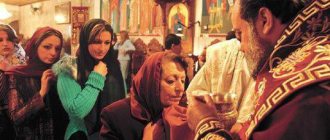Why can't a woman be a priest?
The centuries-old Orthodox church tradition has never known female “priests”; the practice of “ordaining” women to the priesthood and episcopal rank is not accepted by the Orthodox Church.
There are several arguments against the female priesthood. First, “the priest at the liturgy is the liturgical icon of Christ, and the altar is the room of the Last Supper. At this supper, it was Christ who took the cup and said: drink, this is My Blood. …We partake of the Blood of Christ, which He Himself gave, which is why the priest must be the liturgical icon of Christ. ...Therefore, the priestly archetype (prototype) is male, not female” (Deacon Andrey Kuraev, “The Church in the World of People”).
Secondly, a priest is a shepherd, and a woman, created as a helper, herself needs support and advice and therefore cannot carry out pastoral service in its entirety. She is called to fulfill her calling in motherhood.
An equally weighty argument is the absence of the very idea of a female priesthood in Church Tradition. “Holy Tradition is not just a tradition,” explained to us the professor of the Moscow Theological Academy, Doctor of Theology A.I. Osipov. — It is important to be able to distinguish random traditions from traditions that have deep religious roots. There are strong arguments that the absence of a female priesthood is an essential tradition. In the history of the Church, the first century is called the century of extraordinary gifts. Simultaneously with baptism, people received gifts, some of them several at once: prophecy, the gift of tongues, the gift of healing diseases, casting out demons... Gifts obvious to everyone amazed the pagans, convincing them of the significance and power of Christianity. In this age we see a different attitude towards the Jewish Law, from which Christianity historically (but not ontologically) emerged. In particular, a different attitude towards women. Among the saints of that time there are Equal-to-the-Apostles Mary Magdalene, Thekla - women who, in their talents, were on the same level with the apostles, and were engaged in the same thing - preaching Christianity. But nowhere and never was the level of their church veneration connected with the granting of the priesthood to them.
Moreover, when in the 2nd–3rd centuries. A female priesthood appeared in the Marcionite sect; this caused a strong protest from a number of revered saints and teachers of the Church.
The Mother of God, revered above the Angels, was not a priest.
The issue of the inadmissibility of the female priesthood is not covered in detail in theological literature: there are only isolated statements on this matter. But the fact is that in science a new theory is accepted only when there are new facts that confirm it, and fundamental shortcomings inherent in the previous theory. Theology is also a science. So, according to a principle common to all sciences, theological arguments should be presented not by opponents of the female priesthood, but by its defenders. These arguments can only come from two sources - Holy Scripture and the teachings of the Holy Fathers. “Neither in Scripture nor in patristic literature is there a single fact confirming the possibility of a female priesthood.”
For reference: the first female “priest” in the history of Christianity appeared in one of the churches of the Anglican Commonwealth (an association of Anglican churches around the world). Her name was Florence Lee Tim Oy (1907–1992). In 1941, after receiving her theological training, she became a deaconess and served the Chinese refugee community in Macau. When the Japanese occupation of China left the Macau congregation without a priest, the Anglican bishop of Hong Kong ordained her to the priesthood. It was a forced step. Because this was 30 years before any Anglican Church officially allowed female priesthood, Dr. Lee Tim Oi ceased priestly ministry immediately after the end of World War II. She died in 1992 in Toronto; By this time, the female “priesthood” had been introduced in most Anglican churches; the further, the more they deviated from the apostolic institutions, not only in this matter. “Why do Protestants dare to introduce female priests? There is an internal contradiction here, says Fr. Job (Gumerov) , teacher of the Sacred History of the Old Testament at the Moscow Sretensky Seminary. – After all, in disputes with Orthodox Christians, Protestants almost say: “Where does it say this in the Bible?” But on the issue of the female priesthood, they act in exactly the opposite way. Reasoning that if the Bible does not say “no”, then it is possible is formalism, deceit and a refusal to perceive the true spirit of Holy Scripture.”
The late Metropolitan Anthony of Sourozh believed “I am convinced that we must think about this problem with all the strength of our minds, with full knowledge of Scripture and Tradition, and find the answer” (“The Orthodox Church and the Women’s Question,” Bulletin of the RSHD, II-2002). The Bishop wrote about the height and responsibility of the priestly calling: “The priesthood is a state filled with such fear that it is impossible to desire it. It can be accepted almost with sacred awe, with horror, and therefore the priesthood is not a matter of status, unless we reduce the priesthood to the level of unskilled public work and preaching and a kind of “Christian social service.”
The words of the Apostolic Epistles about all believers are well known: “You are a chosen race, a royal priesthood, a holy nation, a special people, that you may proclaim the praises of Him who called you out of darkness into His wonderful light” (1 Peter 2:9). How to understand these words? Metropolitan Anthony of Sourozh explains this idea this way: “It seems to me that we can answer that the universal priesthood consists in the calling of all those who belong to Christ Himself, who through baptism have become Christ’s... to sanctify this world, to make it sacred and holy, to offer it as a gift to God . This service consists, first of all, of offering one’s own soul and body to God as a living sacrifice, and in this offering of oneself, offering everything that is ours: not only feelings, and soul, and thoughts, and will, and the whole body, but everything we do, everything we touch, everything that belongs to us, everything that we can free with our power from slavery to Satan is through the act of our own faithfulness to God.”
Protopresbyter Nikolai Afanasyev, in his famous work “The Church of the Holy Spirit,” separates the ministry of the royal priesthood - common to all the faithful, and the ministry of governance - shepherding or “special”, hierarchical priesthood. The royal priesthood is understood in only one way - as the co-service of the entire church community in the celebration of the Eucharist. But the assembly of the faithful cannot exist without a primate, a shepherd who has received special gifts of governance. “Government belongs only to those specially called, and not to the entire people, whose members have not received the gifts of government, and without grace-filled gifts there can be no service in the Church. Therefore, the ministry of shepherds is different from the ministry of God’s people.” It is precisely this kind of pastoral service (presbyterian and episcopal), according to Tradition, that women are not allowed to serve.
The altar is the holy of holies of an Orthodox church
There is a throne on which the Sacrament of Holy Communion is performed.
The altar is an image of the Kingdom of Heaven, a mountainous, sublime place. There are usually three doors leading to the altar. The central ones are called the royal doors. They are opened in special, most important and solemn places of service: for example, when the priest brings out the chalice with the Holy Gifts through the royal doors, in which the King of Glory, the Lord Himself, is present. There are side doors on the left and right of the altar barrier. They are called deacons, since clergymen, called deacons, most often pass through them during services.
Altar is translated as an elevated altar. And indeed the altar is located higher than the middle part of the temple. The main part of the altar is the Throne, on which the Bloodless Sacrifice is performed during the Divine Liturgy. This sacred action is also called the Eucharist, or the Sacrament of Communion. We'll talk about it later.
Inside the throne are the relics of the saints, for in ancient times, in the first centuries, Christians celebrated the Eucharist at the tombs of the holy martyrs. On the throne there is an antimension - a silk cloth on which the position of the Savior in the tomb is depicted. Antimins translated from Greek means instead of a throne, since it also contains a piece of holy relics and the Eucharist is celebrated on it.
At the antimension, in some exceptional cases (for example, during a military campaign), the Sacrament of Communion can be performed when there is no throne. On the throne stands a tabernacle, usually made in the form of a temple. It contains spare Holy Gifts for giving communion to the sick at home and in the hospital. Also on the throne is the monstrance, in which the priests carry the Holy Gifts when they go to give communion to the sick. On the throne is the Gospel (it is read during the service) and the cross. Immediately behind the throne there is a seven-branched candlestick - a large candlestick with seven lamps. The seven-branched candlestick was still in the Old Testament temple.
Behind the throne on the eastern side there is a high place, which symbolically marks the heavenly throne or the chair of the eternal High Priest - Jesus Christ. Therefore, an icon of the Savior is placed on the wall above the high place. On the high place there is usually an altarpiece of the Mother of God and a large cross. They are used to wear during religious processions.
In those churches where the bishop serves, behind the throne on stands there are dikiri and trikiri - candlesticks with two and three candles, with which the bishop blesses the people.
Have women always been excluded from the altar?
Widows, virgins or nuns after 40 years can become an altar server - that is, clean the altar, serve the censer, read, go out with candles. In the Holy Land, in the Church of the Holy Sepulcher, any pilgrim or pilgrim can enter the Edicule - the cave where Christ was resurrected and which serves as the altar of the temple - and venerate the deathbed of the Savior, that is, St. to the throne. Many are confused by the fact that at Baptism, boys are brought into the altar, but girls are not. However, it is known that until the 14th century, all children on the fortieth day after birth were churched (“fortiethly”) - brought into the altar. Moreover, both boys and girls were applied to St. to the throne. Children were baptized at about three years old, and infants only in case of danger. Later, after children began to be baptized earlier, the rite of churching began to be performed not before, but immediately after Baptism, and then girls were no longer brought to the altar, and boys were no longer brought to the Holy Cross. to the throne.
The concept of the altar among Catholics and Orthodox
- In Orthodoxy,
the altar is the eastern part of the temple, which only priests are allowed to enter. It is usually separated from the prayer hall by an iconostasis or simply a fence. And already in the altar itself there is a throne on which the objects necessary for the rituals are located: the Gospel, the antimension and the cross. - In Catholicism,
the altar is the throne itself. They also place a cross, the Gospel, and sometimes items for communion on it: wine and bread. Here the altar is not fenced off, but open. Its purpose is to perform the sacraments. Sometimes several altars are installed at once, more often in large churches.
Why are women not allowed to visit Mount Athos?
Holy Mount Athos is a peninsula in Greece on which 20 large monasteries are located (not counting smaller monastic communities). In Byzantium, women were strictly prohibited from entering all monasteries. The Holy Mountain is considered the earthly destiny of the Mother of God - legend says that the Most Holy Theotokos and the Evangelist John set off on a sea voyage, but were caught in a storm on the way and lost their course, eventually landing at the foot of Mount Athos, in the place where Iversky is now located monastery. Struck by the beauty of these places, the Mother of God asked the Lord to make the Holy Mountain Her earthly inheritance. According to the covenant of the Mother of God, no woman except Her can set foot on the land of Athos. In 1045, under the Byzantine Emperor Constantine IX Monomakh, a statute was adopted for the Athonites, officially prohibiting women and even female domestic animals from being on the territory of the Holy Mountain. A Greek Presidential Decree of 1953 provides for imprisonment of 2 to 12 months for women who violate the ban (it must be said that during the Greek Civil War of 1946–1949, refugee women found refuge on the Holy Mountain, as they did more than once during Turkish rule). Maintaining the ban was one of the conditions put forward by Greece for joining the European Union. Despite this, various EU bodies periodically try to challenge this point. Until now, this has not been possible, since Athos is formally in private ownership - the entire territory of the mountain is divided into twenty parts between the monasteries located here. It should be noted that the Byzantine ban on visiting monasteries by persons of the opposite sex in Greece is still observed quite strictly - not only on Athos, but in many monasteries women are not allowed, and men (except for serving clergy) are not allowed into most nunneries.
What about Catholics?
In all Christian churches, the altar takes pride of place. Representatives of all denominations of Christianity treat this sacred place with special reverence. In a Catholic church, the altar or presbytery is located behind a low partition, and it is not difficult for anyone to step over it. However, this should not be done, since ordinary parishioners are prohibited from doing this in the same way as in Orthodox churches. Ordinary laity are allowed to enter the presbytery only in cases of extreme necessity.
Where did the deaconesses go?
Deaconesses as a special female church ministry appeared around the 4th century after the Nativity of Christ (although Deaconess Thebes is mentioned in the Epistle of the Apostle Paul to the Romans, historians believe that at that time the rite of becoming a deaconess had not yet been established). In the subsequent Byzantine tradition, unmarried women over 50 years of age could become deaconesses: widows, virgins, and also nuns. The order of the rites of ordination of a deaconess and a deacon was almost the same (but the prayers of ordination, of course, were different) - at the end of the ordination the deacon was given the Chalice, and he went to give communion to the believers, and the deaconess put the Chalice back on the Holy. throne. This expressed the fact that the deaconess had no liturgical duties (the only known independent role of deaconesses in worship was related to maintaining decency during the Baptism of women: after the bishop or priest poured holy oil on the forehead of the baptized person, the rest of the body was anointed by the deaconess). Deaconesses performed administrative functions in charitable institutions and led women's communities. In Byzantium, deaconesses existed until the 11th century (by this time only schema-nuns could become deaconesses); in the West, they disappeared about half a millennium earlier - largely due to the destruction of the social structure within which they were required. In Byzantium, the need for deaconesses disappeared for similar reasons - social charitable institutions no longer needed them. Later, the institution of deaconesses was not restored, since there was no need for them. True, several deaconesses were ordained by St. Nektarios of Aegina (1846–1920), the founder of a convent on the Greek island of Aegina, but this experience was not continued. There have never been deaconesses in Russia - in the oldest Slavic manuscript of the rites of ordination (bishop's Trebnik RNL. Sof. 1056, 14th century) the rite of ordination of a deaconess is absent.
Certain Requirements to be Observed by the Church
- For both Catholics and Orthodox Christians, the altar should be located in the eastern part of the temple and face east.
- Catholics should have no more than one service per day at one altar. This sometimes explains the presence of several altars in one temple.
- In Orthodoxy, only clergy of the highest hierarchy are allowed into the altar.
- According to the law of church law, only presbyters, bishops and deacons can receive communion at the altar. But in practice, it is sometimes allowed for the laity to receive communion at the altar (in exceptional cases). For example, students of theological seminaries.
Only altar servers are allowed to the altar. These are men who, of their own free will, assist the clergy at the altar. That's why they are called that.
Just a rib or the whole half?
According to one interpretation of the Bible, God created woman not from the man Adam, but from the man Adam, dividing him into two halves: male and female. Metropolitan Anthony of Sourozh comments on this passage: “Translations of the Bible often say that God took Adam’s rib (Gen. 2:21). The Hebrew text offers other translations, one of which speaks of a side rather than an edge. God did not separate the rib, but separated two sides, two halves, female and male. Indeed, when you read the text in Hebrew, it becomes clear what Adam is saying when he comes face to face with Eve. He exclaims: She is a wife, because I am a husband (Gen. 2:23). In Hebrew it sounds: ish and isha, the same word in the masculine and feminine. Together they make up a person, and they see each other in a new richness, in a new opportunity to grow what is already given into a new fullness.
The horrors of Domostroy are exaggerated
For some reason, it is believed that all the horrors of traditional family life are described in “Domostroy” - a Russian family charter of the 16th century (the famous priest Sylvester was the author of only one of the editions of “Domostroy”). However, in this book we find only one quote that can be interpreted as encouraging corporal punishment for women: “If the husband saw that his wife was in disarray and the servants, or that everything was not as described in this book, he would be able to instruct his wife and teach her useful things.” advice; if she understands, then let her do everything like that, and respect her and favor her, but if the wife is such a science, does not follow the instructions and does not fulfill it (as is said in this book), and she herself does not know any of this, and the servants do not teaches, a husband must punish his wife, admonish her with fear in private, and having punished her, forgive and reproach, and gently instruct, and teach, but at the same time neither the husband should be offended by his wife, nor the wife by her husband - always live in love and harmony.”
Imperfections
We conducted a short survey of men regarding what typical qualities of women could be called “imperfections.” Most common answers:
- excessive emotionality
- talkativeness
- illogic of thinking and behavior
- excessive attention to appearance – your own and not only
- a woman prefers discussion to thinking and analysis
- quarrelsomeness
- envy
In general, we can say: the lack of independence and lack of self-sufficiency of women is a consequence of the fact that a woman was created as an assistant to a man, and not on her own
Perhaps the woman is unclean?
This assumption about feminine nature as perceived by Christian apologists is the first thing that comes to mind; it is stereotypical. Why should a woman not enter the altar, except because she is an unclean being, unworthy to be in the sanctum sanctorum?
In reality, of course not. If the fair sex were seen by the Orthodox as something dirty, then at a minimum no one would venerate the Most Holy Theotokos and many holy women. For Christian morality, there is no fundamental difference whether we are men, women, priests or lay people. We all move towards salvation in God. Thus, this is not an answer to the question of why women cannot enter the altar; the Church makes demands on everyone, regardless of gender.
Is no one offended?
How widespread is dissatisfaction among church women with the place the Church assigns them? We asked several prominent Orthodox women about this (see below). To our surprise, there was not a single offended person among our interlocutors!
Maybe the fact is that in the Church any conversation from the position of “I have the right” is completely unfruitful? None of us - men or women, it doesn’t matter - can demand anything “for ourselves” - because love does not seek its own. You can only demand from yourself. How good it is that it is easier for the feminine, softer and more compliant nature to understand this!
What should those who are still offended do: men won’t let them say a word? I think there is some consolation. If you really have something to say, and the content of your soul and your words is really important, you don’t have to be afraid, you will be heard. How the holy women were heard - so much so that the memory of them and their words were preserved through the centuries.
Yulia Danilova, editor-in-chief of Neskuchny Sad magazine
Why should women remain silent?
In our age of feminism, the church’s attitude towards women, at first glance, seems discriminatory, even outrageous. But this is only at first glance, from the outside. Judging by our survey of women themselves, they do not think so at all
“Let your wives be silent in the churches...” (1 Cor. 14:34) Women are not allowed to be priests. They are not allowed into the altar or on Mount Athos. Don't Orthodox Christian women feel offended? – we asked famous women of the country.
Natalya Loseva, head of Internet projects at RIA Novosti: – In my opinion, it doesn’t hurt to bring back some traditions of behavior between men and women in the church: for example, the custom of women standing on the left and men on the right. I think (to the extent that I am generally allowed to comment on the apostles) that the words “let a woman remain silent in the Church” are true for all times. And in their literal interpretation, implying reverent silence. How many times have I cut myself off when you stand at the cross and while away the minutes chatting with a friend, and next to you are the communicants who are experiencing their Silence at this time, prayers of thanks are being read or a prayer service has begun. They are all the more true, in my opinion, in the sense that it is not a woman’s place to preach at the altar, and there is nothing offensive or derogatory in this, because the laws and traditions of the fathers do not carry a ritual, but a deep, sacred meaning. Are you offended that a man does not give birth to children and does not have regular illnesses? What about the fact that you can't grow a beard? Why is it that each of us is ready to calmly and naturally accept bodily, physiological differences, but someone resists another, more subtle difference? I’ll tell you moreover, I’m afraid that one day, for the sake of pseudo-liberalism, a woman’s foot will set foot on Athos. There are traditions that we need to hold on to with our teeth, even if we cannot comprehend their full, real, unconditional meaning. Recently, my friends and I said, going through our “Orthodox crowd,” that if a man came from a non-church family in adulthood to the Church, then this is a cement adhesion. They are stronger in faith.
Irina Yakovlevna Medvedeva, Orthodox psychologist: - I think that the words of the apostle refer to those times when not only clergy, but also male laity had the right to preach in church. I’m not at all offended that I’m not allowed into the altar. It is much more offensive when men do not give way to women or do not shake hands when exiting a vehicle. And only weak and inferior men in some respects assert themselves at the expense of women. After all, a woman is undoubtedly weaker than a man when it comes to generosity and condescension.
Antonina Vasilyevna Mitiguz, lieutenant colonel of the internal service of the Ministry of Justice of the Russian Federation: – If you adhere to church rules, then men approach the cross and the chalice first. And I am pleased to let the men go first - this is my tribute to those few men who go to church today. In women, the tongue very often precedes the mind, so the common phrase: “My tongue is my enemy,” unfortunately, characterizes the majority of women. I also try not to forget the words of Rev. Ambrose of Optina, who warned that “sorrows are sent to those who talk in the temple.” From my personal observations, I can say that if a man came to faith, he did it consciously and seriously. Moreover, he is likely to be a true soldier of Christ and will not show off his faith and his good works. A woman loves external manifestations and discussions of her affairs and is often touched by her outwardly pious appearance. During fasting, a woman often pays serious attention to food restrictions rather than working on her inner content.
Abbess of the Novo-Tikhvin Monastery Lyubov (Nesterenko): - It is enough that the Apostle Paul said this, and there would be no need to argue further. The Word of God is immutable. The Book of Proverbs says: “Do not transgress (that is, do not cross, do not violate) the limit of the eternal” (22, 28), and the Savior Himself said: “Heaven and earth will pass away, but My words will not pass away.” This is an eternal law and it is sacred to us. An example can be given from the First Book of Chronicles. When the ark of God was being transported, Uzzah, not being a priest, touched it and died at the same moment. It would seem, what bad did he do? He just wanted to support the ark so that it would not fall off the chariot. But he rushed into a ministry that was not intended for him. In the same way, when we dare to transgress the limits set by the Word of God regarding our ministry, we die. Moreover, we may not even feel this death, since we live a more spiritual life than a spiritual one, and some spiritual things are completely unknown to us. But if we do not feel this now, during the days of our earthly life, then the consequences of this will certainly appear when we cross the threshold of death. If we sincerely believe, and do not just call ourselves Christians, then we submit with love to Divine Revelation. Then we develop an appropriate heart structure, and it does not even occur to us to think about whether we are being oppressed or not. If we go beyond the scope of Holy Scripture, then we enter, so to speak, into the realm of passions, and naturally, vanity, pride, dissatisfaction with our position and grumbling against Divine institutions arise in us. Scripture assigns a specific role to women. If we turn to the Book of Genesis, we will see that the Lord created Eve precisely as a helper. What is a helper? Even in our modern understanding, this is a person with disabilities. From the point of view of natural talents, women are inferior to men in physical strength, and also in intellectual terms. Which women became famous in the field of philosophy or theology? On the other hand, as Christians we should not talk only about natural abilities. For us, another question is more important: who is superior in terms of knowledge of God? And about this most important subject for us, the Holy Scripture says that in this we are equal - “neither male nor female” (Gal. 3:28). With regard to the knowledge of God - it should be emphasized: not theoretical, but living, experimental knowledge of God - women are in no way inferior to men. When it comes to communion with God, even some natural “deficiencies” are covered by Divine grace. For example, if we talk about bodily weakness, we can cite the example of the martyrs who, by the power of Christ, endured supernatural torments, torments no less than those that befell men. Let us remember the martyr Felicity. She could not hold back her screams when she gave birth (she was imprisoned while pregnant), and a few days later she endured terrible torment for Christ without a single groan. Also, regarding the depth of reasoning, the words of the Savior were fulfilled not only on men, but also on women: “When they bring you into the synagogues, before the principalities and powers, do not worry about how or what to answer, or what to say, for the Holy Spirit will teach you in the hour that we must speak” (Luke 12:11-12). So, we are equal in the most important thing, we have the same calling, and on our path to the Kingdom of God, only our own determination and zeal for salvation matters.
Elena Soboleva, author of the book “The Fifth Angel Sounded”, film director, teacher at domestic and foreign film schools: – In general, it’s very difficult to oppress me - I’m still a film director, I know how to stand up for myself in any situation. But, in general, no one ever offends me, because people simply feel at first glance some kind of personal status. We don't really need to go into the altar. But questions about, say, bare head or a reconsidered attitude towards makeup may be subject to discussion. I don’t think that our royal new martyrs - queens and princesses - walked around without jewelry and without makeup. However, this did not stop them from becoming saints. Our history is moving towards the end of the world. This is also reflected in the fact that the male sex is becoming more and more decorative. It no longer corresponds at all to the traditions that have existed for thousands of years in human society. Almost every politician has female ears sticking out. Who made, for example, Clinton Clinton, and Gorbachev Gorbachev? A woman has less of this desire to prance and compete. Men compete with each other from birth to death. And a woman is characterized by self-sacrifice - she takes care of her husband and children. Therefore, a woman is more likely to be constancy. And a man is disposable. He can wave a sword, show courage once, accomplish a feat and lay down his head. This is the most changeable group of humanity - men. And therefore they are especially affected by modern environmental and social problems.
Frederica-Maria de Graas, psychologist and massage therapist, volunteer employee of the Moscow hospice: – There are few men in the church, much less than women, and I don’t feel any oppression on their part. I think the apostle called on women to leave idle talk in order to feel their unity with God in the Temple. It is much easier for a woman to do this than for a man, since she is more sensitive and intuitive. The Apostle said that a woman should give up her curiosity, envy and desire to talk - then her natural ability to perceive the presence of God will turn on. It is easier for her to accept this than for a man. “Let a woman remain silent in church” in order to serve God and be closer to Him. The altar is a place so sacred that a person can only enter there with a feeling of colossal trepidation, because this is the place where the Almighty is. I haven’t grown up to this yet - just being in the temple is enough for me. Both men and women in the temple are united, I don’t feel any division - we are all “One Body of Christ.” Just standing in the temple is already a lot for me. Of course, I would like to be on Mount Athos, because... there is a quiet and convenient place for prayer, but since the Mother of God decided that only men should be there, then I don’t rush there. The fact that women are not allowed to be on Mount Athos does not mean that men are better than women. I think that Athonite monks need no women around, because... this is a place for intense prayer; there should be no temptations or temptations there. Athos is a holy place of prayer. The world needs these prayers. Therefore, there is no division - we are all one “Body of Christ”, this is God’s mercy for the whole world. I think that will and physical strength are more developed in men than in women. A woman is more attached to the earth. A man can purposefully walk towards his intended goal and not notice anything around him, but a woman sees the world more broadly. A man has fewer emotions and this helps him reach his goal. But a woman has a more developed heart and ability to love. It is more difficult for a man to open his heart. I am not at all drawn to be a priest, because a priest is the image of Christ, who “laid down his life for his flock.” Christ Himself commanded this - this is how it was established. The priest must forget about himself, cut off his self for the sake of Christ - not everyone is ready for this.
Tutta Larsen, MTV presenter: – I would rather agree with the words of the apostle. If there is any source of vanity in the temple, it is most often due to the fault of women. The well-known “grandmothers” make comments to those who come to the temple. And often unchurched youth come in wearing pants and without headscarves. It is important at this moment not to scare them away - a person must grow up to everything himself. I believe that there should be no reproaches and condemnation in the church - this is unacceptable. But if the remark is made by the priest in a mild form, the parishioner will probably not be offended and will understand everything correctly. And, in general, the decision to come to the temple, i.e. taking the first step is a very difficult decision. Once I came to the Danilovsky Monastery for Christmas, and they asked me to move away from the altar - this fact then greatly outraged and upset me. Now I'm okay with it. A woman is more emotional; she can, with her feminine energy and her emotions, both create and destroy, for example, harmonious relationships in the family. A man must curb female energy and direct it in the right direction. And the strength of a woman, in my opinion, lies in the fact that she gives birth to children, keeps the hearth, that is, she is “living water”, which strengthens a man and makes him stronger. I think that a woman cannot be a priest due to her weakness. She was probably created for someone else - for her husband and for her children.
Oksana Fedorova, host of the “Good Night, Kids” program: “I come to church to be alone with myself, and men do not interfere with me in this at all.” I think the apostle did not mean that a woman should remain silent in the church itself. He meant the family as a small Church. A wife should listen to her husband, that is, not take on a leadership role. The Church has established that a woman should not enter the altar, and we should not argue with this. Although, I heard that nuns who have been in the monastery for a long time, that is, who have reached some spiritual heights, are allowed to enter the altar. A woman is physically weaker than a man, but psychologically she is stronger. A lot rests on women’s shoulders: family, home, children and creating an atmosphere in the family. A woman does all the small work - she is more diligent. And when you need to make operational decisions and act quickly, here the palm is given to the man because he is more logical and sober. Women are dominated by emotions. This has its pros and cons. As they say, if a branch is tough, it breaks quickly, and if it is flexible, like a woman, then it is tenacious, capable of adapting to many things. There are convents where the abbess of the monastery are women, but the services are still conducted by men. When a priest serves, he becomes like Christ. Since Christ was a man, then, probably, the priest should be a man.
Elena Chudinova, writer, author of the book “Notre Dame Mosque”: – I was simply shocked by the wave of attention and respect expressed to me by the clergy, which was caused by the appearance of my novel “Notre Dame Mosque”. I met so much approval, understanding, support and questions for me as a writer, as a thinker, from the clergy! Against the background of all this, it would be funny for me to say that there is discrimination against women in the church. But this is one side of the coin. On the other hand, I can consider myself as an ordinary, believing woman. And as such, I must - and this is completely natural and does not cause me any protest - remember that the wives are silent in the temple. We are Orthodox, we are not heretics who ordain women as bishops! And the woman in the temple does not preach. Apparently, this also implies some humility, that is, covering the head. After all, we still confess that we bear the sin of our ancestress Eve. Therefore, this is natural, and if this seems abnormal to someone, they need to choose another religion, a more “tolerant” and “politically correct” one. But there are episodes that personally upset me. Recently, at a rally on Pushkin Square, out of respect for those who came to this rally, in accordance with my status as a married woman, I covered my head and put on a smart hat. And a very good priest asked me to take off my hat. Then I asked him, a little jokingly: “Father, why did you fool a married woman?” He answered me innocently: “If I had a handkerchief in my pocket, I would offer it myself.” Moreover, he was a worthy shepherd who commands every respect. Apparently, the implication was that the fashionable hat was somehow not good. You understand, I shouldn’t wear a headscarf, because I’m not a “woman”, my husband is not a “man”. By social status, I am a lady, and the appropriate headdress for a lady is a hat. A shawl, for example, but not a scarf. I think it’s a terrible relic when women with a diploma in art history or philology enter the temple, tying some ugly old woman’s white scarves!
magazine "Neskuchny Sad"
Story
Altars appeared at the dawn of Christianity. In those days, in the catacomb churches, where Christians were sometimes forced to hide, the relics of the holy martyrs were fenced off in the eastern part. The relics were kept in a sarcophagus - a special stone tomb. It was there that the Sacrament of the Eucharist was performed in remembrance of our Lord Jesus Christ according to His Testament.
The altars were located on a higher elevation compared to the other areas of the temple and symbolized the Throne of the Lord. Therefore, they always try to keep the Altar clean and decorate it with carpets, but not everyone has the right to enter there. Where the Sacrament of the Eucharist is celebrated, the Last Supper symbolically takes place, when Christ gathered His disciples. Previously, in Old Testament times, the altar was called the “Holy of Holies.”










